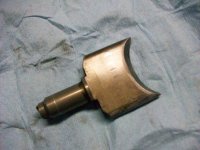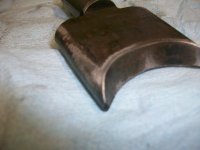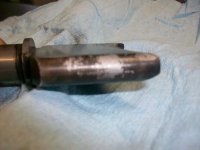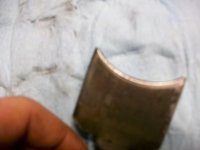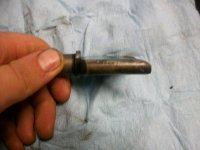BRAAAPPP420
New member
im cleaning my power valves with carb cleaner and there not coming clean. whats the best way to clean these with..like what kind of untencil could i use?
thanks.
thanks.
i take mine off and put the wire wheel to them, 


super1c
Super Moderator
Break cleaner and a green scotch brite pad. Scrap thick carbon off with razor blade. CCC
BRAAAPPP420
New member
i was gonna use a wire brush but a friend told me that it would scratch them. thanks for your in put though...does the brake cleaner bite in better then the carb cleaner
BRAAAPPP420
New member
so i used the wire wheel and is there suppose to be a coating thats on it cause i did the edges and the "coating" was rubbed off does it matter?
rx1jim
New member
Here is what I do:
1. CAREFULLY remove most of the carbon deposits using new razor blades. BE careful to NOT "dig" into the valve, especially at the sharp edges on the valve. The valve is aluminum which has been anodized to put a thick, hard protective layer of aluminum oxide on the surface. The purpose of the aluminum oxide layer is to prevent the valve from binding in the cylinder due to aluminum valve sliding on the aluminum port in the cylinder. Gently scrape the valve to get most of the carbon off.
2. I use a scotchbrite pad with a hand cleaner that has an abrasive in it. I scrub the surface until the valve is completely clean. Keep the valve and scotchbrite pad wet while you scrub. There is no replacement for for good old "elbow grease"
3. I wrap a wood dowel with a shop towel and swap out the valve pocket in the cylinder to remove the carbon debris from the valve pocket. You wnat to be careful to drag the debris out rather than pushing it deeper into the pocket and cylinder
4. Clean the cylindrical steel bushing with scotchbrite and the hand cleaner to remove all signs of carbon deposits.
5. Check the valve for evidence of the servo cable end pulling through the top of the valve. You can do this by slidingthe cable back into the retainer slot and feel for a pocket forming in the center of the slot. Pull through is caused by the servo motor pulling on a valve which is sticking in the valve pocket due to excessive carbon build up.
6. Slide the valve and bushing back into the cylinder and check for smooth operation. It the valve does not operate smoothly, look into the valve bore for carbon deposits and clean them out. If you have a valve which is suffering from cable pull through, YAMAHEAD on this site can fix you up.
7. Reassemble the valve and adjust the servo cable as described in the Tech pages. The seal which rides on the power valve shaft and the 2 o-rings which seal the cable to the housing can be reused many times. I replace the
gaskets every other cleaning. I cut my own gaskets for these valves for gasket automotive gasket material.
Cleaning them more often leads to overall faster cleaning and more importantly smoother operation.
I have tried soaking the power valves in the following chemicals for DAYS to loosen the carbon deposits with NO success:
1. hot transmission fluid
2. warm paint thinner
3. carb cleaner
4. acetone
5. brake cleaner
6. Seafom engine treatment
7. diesel fuel
8. bug, tar and glue remover
DO NOT use any cleaner which contains a strong base such as oven cleaner, Castrol super clean, Spray-9, etc.. The strong hydroxides found in these cleaners will DO NOTHING to break down and lossen the carbon but WILL attack the aluminum valves.
1. CAREFULLY remove most of the carbon deposits using new razor blades. BE careful to NOT "dig" into the valve, especially at the sharp edges on the valve. The valve is aluminum which has been anodized to put a thick, hard protective layer of aluminum oxide on the surface. The purpose of the aluminum oxide layer is to prevent the valve from binding in the cylinder due to aluminum valve sliding on the aluminum port in the cylinder. Gently scrape the valve to get most of the carbon off.
2. I use a scotchbrite pad with a hand cleaner that has an abrasive in it. I scrub the surface until the valve is completely clean. Keep the valve and scotchbrite pad wet while you scrub. There is no replacement for for good old "elbow grease"
3. I wrap a wood dowel with a shop towel and swap out the valve pocket in the cylinder to remove the carbon debris from the valve pocket. You wnat to be careful to drag the debris out rather than pushing it deeper into the pocket and cylinder
4. Clean the cylindrical steel bushing with scotchbrite and the hand cleaner to remove all signs of carbon deposits.
5. Check the valve for evidence of the servo cable end pulling through the top of the valve. You can do this by slidingthe cable back into the retainer slot and feel for a pocket forming in the center of the slot. Pull through is caused by the servo motor pulling on a valve which is sticking in the valve pocket due to excessive carbon build up.
6. Slide the valve and bushing back into the cylinder and check for smooth operation. It the valve does not operate smoothly, look into the valve bore for carbon deposits and clean them out. If you have a valve which is suffering from cable pull through, YAMAHEAD on this site can fix you up.
7. Reassemble the valve and adjust the servo cable as described in the Tech pages. The seal which rides on the power valve shaft and the 2 o-rings which seal the cable to the housing can be reused many times. I replace the
gaskets every other cleaning. I cut my own gaskets for these valves for gasket automotive gasket material.
Cleaning them more often leads to overall faster cleaning and more importantly smoother operation.
I have tried soaking the power valves in the following chemicals for DAYS to loosen the carbon deposits with NO success:
1. hot transmission fluid
2. warm paint thinner
3. carb cleaner
4. acetone
5. brake cleaner
6. Seafom engine treatment
7. diesel fuel
8. bug, tar and glue remover
DO NOT use any cleaner which contains a strong base such as oven cleaner, Castrol super clean, Spray-9, etc.. The strong hydroxides found in these cleaners will DO NOTHING to break down and lossen the carbon but WILL attack the aluminum valves.
tntmax
Member
Try using a Dremel with a polishing pad after you soak them in carb cleaner...
BlueMachine
New member
Yeah I've found that soaking with cleaners does very little good.
I just got done cleaning mine with a Dremel and a two of these http://www.dremel.com/en-us/AttachmentsAndAccessories/Pages/AttachmentsDetail.aspx?pid=511E
My process: use a razor blade to take off the big chunks. Use the dremel for the rest. BE CAREFUL when nearing edges of the powervalves with the dremel, if you aren't cautious then the bit will "catch" on the powervalve and dig into it more than desired. Best to just run it at half speed or so. If you do this patiently, it is WAY more efficient than manually scraping off everything.
I just got done cleaning mine with a Dremel and a two of these http://www.dremel.com/en-us/AttachmentsAndAccessories/Pages/AttachmentsDetail.aspx?pid=511E
My process: use a razor blade to take off the big chunks. Use the dremel for the rest. BE CAREFUL when nearing edges of the powervalves with the dremel, if you aren't cautious then the bit will "catch" on the powervalve and dig into it more than desired. Best to just run it at half speed or so. If you do this patiently, it is WAY more efficient than manually scraping off everything.
BRAAAPPP420
New member
i think i might have dug into the edges because there is a rougher edge then before..what do i do now?
post some pics or email me some i have seen hundreds of valves and some were bad but still get the job done ...some have passed the stoppers and smacked the piston and broke and trashed the motor
Snowsnake
New member
You tried everything but what was made for desolving carbon.Combustion chamber cleaner!GM(Cleans) and Chrysler(probably Ford as well)sell it in a spray and liquid form.I've got approx. 15K miles on my motor with the original valves in it.Cleaned at close to every 1K miles.rx1jim said:Here is what I do:
1. CAREFULLY remove most of the carbon deposits using new razor blades. BE careful to NOT "dig" into the valve, especially at the sharp edges on the valve. The valve is aluminum which has been anodized to put a thick, hard protective layer of aluminum oxide on the surface. The purpose of the aluminum oxide layer is to prevent the valve from binding in the cylinder due to aluminum valve sliding on the aluminum port in the cylinder. Gently scrape the valve to get most of the carbon off.
2. I use a scotchbrite pad with a hand cleaner that has an abrasive in it. I scrub the surface until the valve is completely clean. Keep the valve and scotchbrite pad wet while you scrub. There is no replacement for for good old "elbow grease"
3. I wrap a wood dowel with a shop towel and swap out the valve pocket in the cylinder to remove the carbon debris from the valve pocket. You wnat to be careful to drag the debris out rather than pushing it deeper into the pocket and cylinder
4. Clean the cylindrical steel bushing with scotchbrite and the hand cleaner to remove all signs of carbon deposits.
5. Check the valve for evidence of the servo cable end pulling through the top of the valve. You can do this by slidingthe cable back into the retainer slot and feel for a pocket forming in the center of the slot. Pull through is caused by the servo motor pulling on a valve which is sticking in the valve pocket due to excessive carbon build up.
6. Slide the valve and bushing back into the cylinder and check for smooth operation. It the valve does not operate smoothly, look into the valve bore for carbon deposits and clean them out. If you have a valve which is suffering from cable pull through, YAMAHEAD on this site can fix you up.
7. Reassemble the valve and adjust the servo cable as described in the Tech pages. The seal which rides on the power valve shaft and the 2 o-rings which seal the cable to the housing can be reused many times. I replace the
gaskets every other cleaning. I cut my own gaskets for these valves for gasket automotive gasket material.
Cleaning them more often leads to overall faster cleaning and more importantly smoother operation.
I have tried soaking the power valves in the following chemicals for DAYS to loosen the carbon deposits with NO success:
1. hot transmission fluid
2. warm paint thinner
3. carb cleaner
4. acetone
5. brake cleaner
6. Seafom engine treatment
7. diesel fuel
8. bug, tar and glue remover
DO NOT use any cleaner which contains a strong base such as oven cleaner, Castrol super clean, Spray-9, etc.. The strong hydroxides found in these cleaners will DO NOTHING to break down and lossen the carbon but WILL attack the aluminum valves.
You don't need to worry too much about carbon falling into the cylinder as it will just blow out the exhaust when you start it without damaging anything.
BRAAAPPP420
New member
BRAAAPPP420
New member
i have pics up now.
I soaked mine overnight in OMC outboard engine cleaner, it appears to be the same thing as the GM top engine cleaner or the Mopar Combustion Chamber Cleaner. then I used a wire wheel for the thick stuff, and some scotchbrite for the thinner stuff. I take my time and have never scraped off any of the coating.
BRAAAPPP420
New member
so what does that mean? will my pv be ok to use?
BRAAAP420, those valve's look fine to me, id throw them in adjust and enjoy, if your worried about the coating, ive cleaned mine so many times, every 5-600 miles that their is no coating left on them, my opinion that coating is a hoax bunch of BS, if you have some rough edges i clean that up a bit, cant really tell by pic's, main thing i would worrie about is where the cable goes into the valve, if thats not all wore out your good, if it is their is a site member that can fix them for you,think he can even have them re-coated for you 



